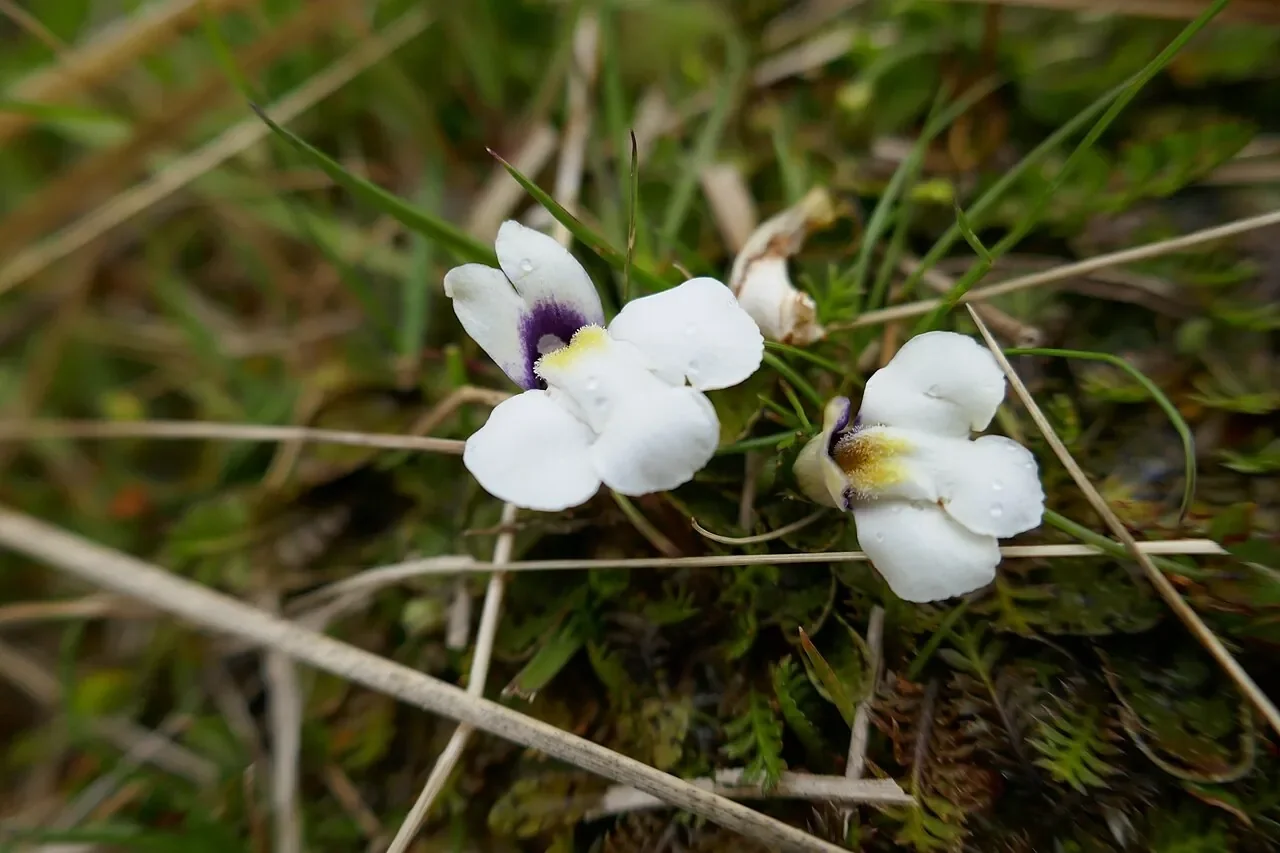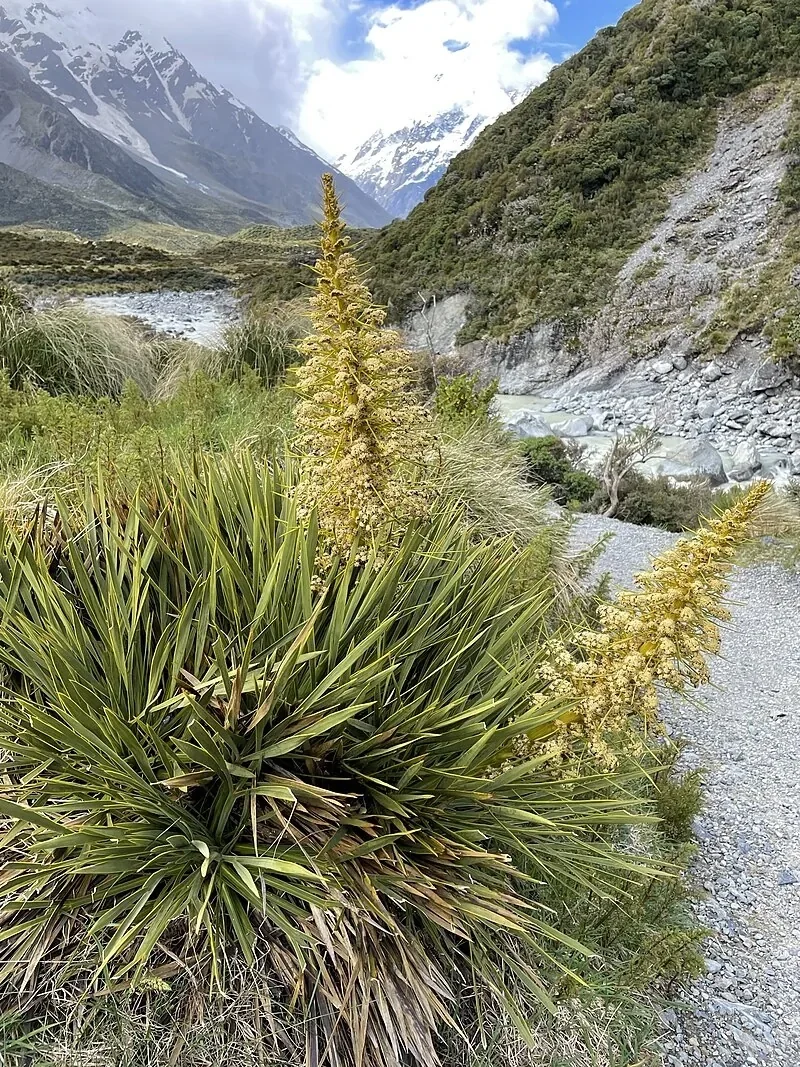
Swamp Mazus
Introduction
Introduction Overview
Swamp Mazus is a creeping, perennial herb native to New Zealand wetlands . Learn more about ground cover plants that thrive in similar habitats.

Plant Description
Botanical Features
Swamp Mazus ( Mazus radicans ) is a low-growing, creeping perennial that spreads by runners over or just under the soil, rooting at the nodes. It typically grows only about 1.25 to 5 cm tall but can spread indefinitely, forming dense mats that effectively suppress weeds. The plant features somewhat hairy leaves and showy white flowers flecked with vibrant purple and yellow hues, which can reach up to 23 cm across. These flowers are particularly interesting as they light up under UV nightlight, resembling "airport runway lights" to night-flying moths, attracting them for pollination. It naturally grows in cool, moist areas, particularly lowland swamps in New Zealand's South Island, and can be found in various altitudes from 100 to 1100 meters.
Quick Facts
Quick Facts Overview
| Scientific Name | Mazus Radicans |
|---|---|
| Height | Varies by species |
| Spread | Varies by species |
| Water Needs | Moderate |
| Light | Full sun to partial shade |
| Frost Tolerance | Moderate |
| Salt Tolerance | Low |
| Growth Rate | Moderate |
| Lifespan | Perennial |
Climate Suitability
Wetland Distribution
Mazus is found in wetlands and damp lowland areas throughout New Zealand, especially in the North and South Islands' wetter regions.
| City | Suitability |
|---|---|
| Whangārei | Ideal |
| Auckland | Ideal |
| Hamilton | Ideal |
| Tauranga | Ideal |
| Rotorua | Ideal |
| Gisborne | Ideal |
| New Plymouth | Ideal |
| Napier | Ideal |
| Whanganui | Ideal |
| Palmerston North | Ideal |
| Wellington | Ideal |
| Nelson | Ideal |
| Christchurch | Ideal |
| Dunedin | Ideal |
| Invercargill | Ideal |
Mazus is adaptable and thrives in wet soils throughout New Zealand.
Natural Habitat
Natural Habitat Overview
Swamp Mazus is naturally found in specific habitats throughout New Zealand. Understanding its natural environment helps in providing appropriate growing conditions in cultivation.
Plant Conservation
Mazus radicans , commonly known as Swamp Mazus or Swamp Musk, is a native New Zealand plant generally considered "Not Threatened" in terms of its conservation status. The New Zealand Threat Classification System (NZTCS) has consistently listed it as "Not Threatened" in assessments from 2004 to 2023. Despite its stable national status, Mazus radicans can be impacted by habitat modification. Habitat loss, primarily driven by human activities such as development and agricultural practices like wetland drainage, poses a significant threat to indigenous plants in New Zealand, including those in the wetland environments where Mazus radicans thrives. An interesting native threat identified is the increasing accumulation of nīkau palm fronds in the understory, which can cover the open ground Mazus radicans needs. This plant is a wetland species, typically found in damp lowland areas across New Zealand's North and South Islands, inhabiting riverbeds, streambanks, forest understory, and modified seepages. It plays an important ecological role by providing dense ground cover, stabilizing soil, retaining moisture, suppressing weeds, and creating microhabitats for small invertebrates and amphibians. Its flowers, which can be purple or white with purple and yellow flecks, attract native pollinators.
Prefers moist , well-drained soils and partial shade. Tolerates wet feet and is ideal for bog gardens or pond edges.
Soil
Prefers moist to wet, well-drained soils; tolerates boggy conditions.
Light
Partial shade to full sun.
Water
High water needs; keep soil consistently moist.
Planting Guide
When to Plant
The best time to plant Mazus is during spring or autumn when soil temperatures are moderate and rainfall is reliable.
How to Plant
Dig a hole twice the width of the root ball and slightly deeper. Place Mazus in the hole, backfill with soil, and water thoroughly. Mulch around the base to retain moisture.
Ecological Role
Wildlife Interactions
Swamp Mazus provides dense ground cover in wetlands and damp grasslands, helping to stabilize soil and retain moisture. Its mat -forming growth suppresses weeds and creates microhabitats for small invertebrates and amphibians. The purple flowers attract native pollinators, supporting local biodiversity. By thriving in waterlogged conditions, Swamp Mazus contributes to the health and resilience of wetland ecosystems and restoration projects.
Uses and Applications
Practical Applications
Mazus has various practical and ornamental uses. From traditional Māori applications to modern landscaping, this versatile plant serves multiple purposes.
Historically, Mazus was used by Māori for medicinal purposes, food, and cultural practices. These traditional uses reflect the deep knowledge of native plants.
Landscaping Uses
Landscaping Uses Overview
Swamp Mazus is ideal for bog gardens, pond edges, and as a living mulch in damp areas. Its dense , creeping growth forms a lush carpet that suppresses weeds and retains soil moisture. The small purple flowers add seasonal colour and attract pollinators, while the plant-s tolerance for wet soils makes it perfect for rain gardens and wetland restoration. Use alongside other moisture-loving natives for a resilient, biodiverse planting.
Seasonal Care
Spring
Spring is the ideal time to plant Mazus as the soil warms and new growth begins. Water regularly to establish roots and apply a light mulch to retain moisture.
Summer
During summer , Mazus may require additional watering during dry spells. Monitor for pests and provide shade if needed in hot climates.
Autumn
Autumn is perfect for transplanting Mazus as the cooler temperatures reduce stress. Reduce watering as growth slows.
Winter
Winter care for Mazus involves minimal maintenance. Protect from severe frosts if necessary and avoid overwatering.
- Plant in well-drained soil
- Apply light mulch
- Water regularly to establish roots
- Monitor for drought stress
- Provide shade in hot climates
- Check for pest infestations
- Transplant established plants
- Reduce watering as growth slows
- Collect seeds for propagation
- Protect from severe frosts
- Avoid overwatering
- Minimal maintenance required
Pruning and Maintenance
Pruning and Maintenance Overview
Mazus generally requires minimal pruning. Remove dead or damaged growth as needed and shape the plant to maintain desired form. Pruning is best done in late winter or early spring before new growth begins.
How to Grow Swamp Mazus
Growing Swamp Mazus is remarkably straightforward, making it an excellent choice for both novice and experienced gardeners. This hardy native groundcover thrives in New Zealand's damp conditions and adapts well to various garden situations. Understanding its natural wetland habitat and creeping growth habit is key to successful cultivation. The plant's tolerance for both sun and shade, combined with its preference for consistently moist soil, makes it versatile for many garden applications from pond edges to woodland understory plantings.
From Seed
Seed propagation offers a cost-effective way to establish large areas of Swamp Mazus, particularly useful for restoration projects and extensive groundcover plantings. Fresh seed typically provides the best germination rates and vigorous growth.
- Collect fresh seeds from mature plants during late summer to early autumn when seed capsules are dry and brown
- Clean seeds thoroughly, removing all chaff and plant debris to prevent fungal issues
- Sow seeds immediately for best results, as they have limited storage viability
- Use a seed-raising mix that retains moisture well, such as 70% peat moss with 30% perlite
- Sow seeds on the surface and lightly cover with a thin layer of fine vermiculite or sifted compost
- Keep soil consistently moist but not waterlogged, using bottom watering to prevent seed displacement
- Maintain temperatures between 15-20°C and provide bright indirect light
- Expect germination within 2-4 weeks under optimal conditions
- Transplant seedlings when they have developed several sets of true leaves and are actively growing
From Division
Division is the most reliable and quickest method for propagating Swamp Mazus, providing instant establishment and maintaining the parent plant's characteristics. This method works exceptionally well due to the plant's naturally spreading, mat-forming growth habit.
- Perform division in early spring as new growth begins to emerge from winter dormancy
- Select healthy, well-established clumps that show vigorous growth and dense coverage
- Water the parent plant thoroughly 24 hours before division to reduce transplant shock
- Use a sharp spade or knife to cut through the root mass, ensuring each section has both roots and shoots
- Aim for divisions that are at least 10-15cm across to ensure strong establishment
- Plant divisions immediately at the same depth they were previously growing
- Space new plants 20-30cm apart to allow for natural spreading and coverage
- Water thoroughly after planting and maintain consistent moisture for the first month
- Expect rapid establishment with new growth visible within 2-3 weeks
From Cuttings
Stem cuttings provide another effective propagation method, particularly useful when plant material is limited or when establishing plants in containers before outdoor planting. This method works well throughout the growing season.
- Take healthy stem cuttings 6-8cm long from actively growing shoots during spring or summer
- Select stems that are neither too soft nor fully hardened, avoiding flowering shoots for best results
- Make clean cuts just below a node using sharp, sterilized secateurs
- Remove lower leaves but retain 4-6 leaves at the tip to maintain photosynthesis
- Dip cutting bases in rooting hormone powder containing IBA at 1000ppm concentration
- Plant in a well-draining propagation mix of equal parts peat moss and perlite
- Maintain high humidity using a propagation dome or plastic bag support system
- Provide bright indirect light and temperatures around 18-22°C
- Keep propagation medium consistently moist but ensure good drainage to prevent rot
- Expect rooting within 3-4 weeks, indicated by new growth and resistance when gently tugged
Establishment and Care
Successfully establishing Swamp Mazus requires attention to its moisture requirements and gradual acclimatization to garden conditions. Proper site preparation and initial care ensure rapid establishment and long-term success in the garden.
- Choose planting sites with consistent moisture, ideally near water features or in naturally damp areas
- Prepare soil by incorporating organic matter such as compost or well-rotted manure to improve moisture retention
- Plant during cool, moist periods in autumn or early spring for best establishment
- Water regularly during the first growing season, ensuring soil never dries out completely
- Apply a thin layer of organic mulch to conserve moisture and suppress competing weeds
- Expect rapid spreading once established, with plants forming dense mats within one growing season
- Allow plants to naturalize and spread to form effective groundcover in suitable conditions
Pests and Diseases
Common Pests
Mazus is generally resistant to most pests due to its native adaptations. However, it may occasionally be affected by common garden pests such as aphids or scale insects.
Disease Prevention
To prevent diseases, ensure good air circulation around Mazus and avoid overwatering. Remove any diseased plant material promptly to prevent spread.
Cultural Significance
Traditional Uses and Values
Mazus radicans , also known as Swamp Mazus, holds cultural significance, particularly in New Zealand where it is native. Historically, the Māori people utilized Mazus radicans for medicinal purposes, as a food source, and in various cultural practices, reflecting their deep understanding of native plants.
Beyond its traditional uses, Mazus radicans is valued in modern contexts for its practical and ornamental applications. It is used in landscaping, especially for bog gardens, pond edges, and as a living mulch in damp areas due to its dense ground cover. Ecologically, it plays a role in stabilizing soil, retaining moisture, suppressing weeds, and providing microhabitats for small invertebrates and amphibians. Its purple flowers also attract native pollinators, contributing to local biodiversity and wetland ecosystem health.
Bonus Tip
Expert Growing Advice
The flowers of Mazus radicans have a fascinating adaptation for pollination. Under UV light, the flowers appear to glow, acting like "runway lights" to guide night-flying moths to the nectar.







